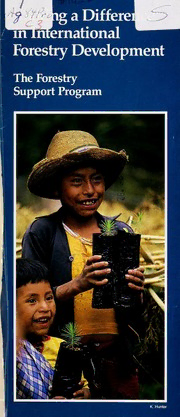Table Of ContentHistoric, Archive Document
Do not assume content reflects current
scientific knowledge, policies, or practices.
The Forestry
Support Program
The Forestry
Support Program
The Forestry Support Program provides technical assis-
tance in forestry and natural resources to the U.S.
Agency for International Development (USAID) and the
U.S. Peace Corps. The goals of the Forestry Support
Program (FSP) are to reduce forest and related natural
resource deterioriation threatening the resource base of
the rural poor and to increase sustainable use of forest
resources around the world.
1. Slash-and-burn clearing of tropical forests. 2. Deterioration of
soil resources in Nepal.
Confronting a Global Challenge
The removal of tropical forests is occurring at unprece-
dented rates throughout the world. Aggregate forest area
in developing countries alone is estimated to have de-
clined by half during this century and continues to decline
at an annual rate of app—roximately 11 million hectares
(about 28 million acres) roughly the size of the state of
Pennsylvania or about 21/2 times the size of Costa Rica.
Forest loss stems from many causes such as conversion
of land for agriculture and grazing, collection of fuelwood
and fodder, and demand for industrial forest products.
This loss threatens the stability of fragile ecosystems
around the world.
During the last decade, there has been increased
awareness of the many diverse roles that forests play in
meeting the basic needs of the world's rural poor. Local
communities derive a broad range of benefits from trees.
These include fuelwood, fodder, fruits, nuts, fibers, tradi-
tional medicines, oils, gums, and other edible and sale-
able products. Trees provide shelter and shade. They
also reduce effects of soil erosion and help sustain soil
fertility, water quality, and wildlife habitat. A variety of so-
cial, economic, and natural resource problems are thus
inextricably linked to deforestation and environmental
degradation.
T. Resch
3. Food aid-supported forestry
programs. 4. USAID-sponsored
sawmill in Gambia. 5. Deforesta-
tion threatens the extinction of
many animal species. 6. Women
in Nepal play an important role in
natural resource management.
7. Selecting eucalyptus housing
material in Morocco. 8. Roadside
firewood market in Senegal.
Making a Difference
Leaders of developing countries increasingly recognize
that their present and future economic well-being is se-
verely threatened if a sound and sustainable natural
resource base is not maintained. Many countries are
encouraging natural resource and environmental
development programs and are working closely with the
United States in these efforts.
—
Agency for International Development Taking a
Leadership Role
In 1979, the U.S. Congress authorized USAID, through
an amendment to the Foreign Assistance Act of 1961, to
increase its bilateral development assistance dealing with
depletion of forests and associated soil and water re-
sources. With this mandate, USAID has taken a leader-
ship role in supporting developing countries as they strive
to cope with their varied natural resource problems.
In the late 1980's, USAID supported over 170 tropical
forestry projects, through annual expenditures of nearly
$80 million, in some 50 developing countries in Africa,
Asia and the Near East, and Latin America and the Carib-
bean. With growing national and international concern
and explicit mandates from the U.S. Congress through
foreign assistance legislation, it is anticipated USAID will
continue to exercise its leadership role through its devel-
opment assistance and food aid-supported projects.
G.Wetterberg
9. Foddercollection in Nepal. 10. Forestry crew in Morocco.
11. Local timber harvesting in Nepal. 12. Peace Corps forestry
training workshop in Botswana. 13.Tree improvement research.
Forestry Support Program—Focusing U.S. Forestry
Assistance
In recognition of the urgent need to enhance the role and
success of forestry development and to fulfill a variety of
associated objectives, in 1981, USAID formed the Office
of Forestry, Environment and Natural Resources, within
the Bureau for Science and Technology.
To enhance USAID's capabilities to design, implement,
and evaluate forestry projects, FSP, a unit of the U.S.
Department of Agriculture's (USDA) Forest Service, Inter-
national Forestry Staff, was established in 1981. FSP is
jointly managed by the USDA Forest Service and the Of-
fice of International Cooperation and Development with
funds provided through USAID's Forest Resources Man-
agement Project. Almost $20 million was appropriated for
this project over the first decade, with continued activities
anticipated through the next.
The Forestry Support Program's Role
The Forestry Support Program carries out its role in for-
estry and natural resource development through a num-
ber of specific support activities:
—
• Technical consultations To provide USAID's re-
gional bureaus, regional offices, and field missions with
technical advice and project design assistance in the
areas of tropical forestry, biological diversity, conserva-
tion, and natural resources.
• Roster development and referrals—To develop and
manage a roster of forestry and natural resource ex-
perts used to identify qualified individuals for long-term
and short-term USAID or cooperative USAID-Peace
Corps assignments overseas.
• Forestry—program studies and technical reference
services To provide technical forestry information to
USAID and Peace Corps staffs and to facilitate the ex-
change of technical information among natural resource
project personnel.
—
• Forestry training To organize forestry training
courses, develop training materials, provide advice to
forestry schools and other organizations on curriculum
design, assist USAID in designing training components
for forestry projects, and provide a communications link
between USAID and educational institutions in the
United States.
• Research support—To provide USAID with techn'cal
support in forestry research.
• Forestry Private Enterprise Initiative—To stimulate
forest-based enterprise by focusing on potential market
enhancement, strengthening private institutions, ex-
panding related income and employment opportunities,

